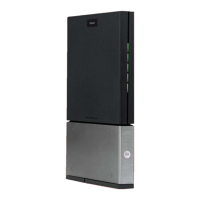
Do you have a question about the Motorola CPEi 750 Series and is the answer not in the manual?
| Brand | Motorola |
|---|---|
| Model | CPEi 750 Series |
| Category | Network Hardware |
| Language | English |
Provides an introduction to the Motorola CPE Indoor (CPEi) 750 desktop device, highlighting its features.
Lists the key features of the CPE device, including WiMAX, DHCP, Home Gateway, Firewall, and Port Forwarding.
Describes the LED Link/Activity indicators on the front of the CPE unit and their status meanings.
Details the physical connectors and buttons on the back of the CPE unit.
Specifies the operating temperature range for the CPE unit.
Guides the user to review sections for installation of the Desktop CPEi 750 Series.
Instructs the user to verify received items before starting the installation process.
Provides step-by-step instructions for physically connecting and powering up the CPE device.
Explains how to connect the CPE to a multi-port switch for multiple computer connections.
Details the steps to access the CPE's web interface for configuration.
Guides through the initial setup wizard, including password change and WiMAX authentication.
Explains how to change the CPE's login password for security.
Describes how to set the device's time zone and Daylight Savings Time.
Details the WiMAX authentication methods (EAP-TLS, EAP-TTLS/MS-CHAPv2).
Covers managing Voice over IP (VoIP) services and status screens.
Illustrates and describes the status screen showing network and telephony connection details.
Shows the location of the restart button for the device.
Introduces the Personalize menu and its available tabs.
Details the fields and functionality of the Password tab for login protection.
Explains the options for setting the device's time zone and Daylight Savings Time.
Describes how to change the device name for network access.
Explains how to reset the CPE to default settings.
Introduces the Internet menu and its sub-tabs for network configuration.
Provides details on authentication methods like EAP-TLS and EAP-TTLS/MS-CHAPv2.
Advises consulting the service provider for IP settings configuration.
Explains how to configure the firewall for network protection and access management.
Describes how to configure Dynamic DNS for non-static IP addresses.
Introduces the Status menu for checking network and telephony connection status.
Provides status information for the WiMAX Wireless Broadband connection.
Provides status information for the telephony connection.
Introduces managing Voice over Internet Protocol (VoIP) services and related settings.
Details settings for VoIP accounts, including user names and passwords for Line 1 and Line 2.
Explains how to customize ring tones for telephone lines.
Describes settings for managing Caller ID features, including call rejection.
Details features for managing call forwarding on telephone lines.
Describes how to check voice mail status for telephone lines.
Lists special dialing numbers for VoIP phone services.
Introduces port forwarding for directing incoming traffic to specific LAN hosts.
Explains UPnP IGD and DMZ settings for port forwarding configuration.
Lists options for configuring port forwarding rules (protocol, ports, IP address).
Introduces menu for configuring Local Area Network (LAN) connections.
Explains the DHCP server settings for assigning IP addresses to LAN clients.
Details enabling and configuring the DHCP server, IP address ranges, and lease time.
Describes how to view active DHCP leases and their details.
Explains how to reserve IP addresses for specific devices.
Introduces the Control Panel section for viewing/updating software information.
Explains how to manage, upgrade, or uninstall device software.
Describes managing device certificates, including importing and removing them.
Introduces managing additional CPE device features.
Details system settings like language, WiMAX radio, LEDs, and refresh intervals.
Describes how to view basic CPE device properties like model and serial number.
Provides step-by-step instructions for enabling TCP/IP in Windows 2000.
Provides steps to configure TCP/IP settings on Windows XP.
Provides basic checks for power-related issues with the CPE.
Offers troubleshooting steps for computer login problems to the CPE.
Lists steps to diagnose and resolve internet connectivity issues.
Advises contacting the service provider for further assistance.
Lists standards the product complies with regarding RF energy exposure.
Provides guidelines for operating the transmitter to meet FCC RF exposure requirements.
Details FCC compliance rules, including conditions for operation and interference.
Provides compliance information for Industry Canada regulations.
States the product's compliance with EU R&TTE Directive and lists applied standards.
Provides information on EU WEEE directive compliance for equipment disposal.
Instructs on proper disposal of Motorola equipment in EU countries.
Provides guidance for disposing of equipment in non-EU countries.
Explains the China Management Methods (CMM) Disclosure Table for compliance.
Discusses copyright and trademark information related to the manual and products.
Outlines restrictions on the use and disclosure of the software and documentation.
Warns against using the product in hazardous, fail-safe environments.
Lists Motorola trademarks and states other names are property of their owners.